
Click on image for
Ninth Day Intro


It's a well-paced, thoroughly
researched, and engaging
bioscience/medical
thriller unlike anything
else in the market


It's a big book:
290,000 words
|

  
 
As readers, we each have an idea of what we like in a work of fiction. Our
individual preferences may differ widely, but one common theme
unites us in the search for that next great book: we're all looking for a
story sizzling with new ideas. We want to go where we've never been before.
Here are some of the themes explored in
Ninth Day of Creation
which promise to do just that---take you on a journey through the scientific
landscape of the near future, and do it while delivering a great story in the
traditional thriller format:
- The realization of a scientifically feasible cure for AIDS, based
on a novel triple-helix genetic medicine (see image on
this page, third strand in yellow). In real life these drugs have
been thwarted by basic problems in biochemistry which the hero,
Richard Kirby, manages to solve.
- An exploration of what it would mean to solve the "protein
folding problem" in biology. The implications are presented
not only for medicine---gene therapy, cancer research, etc---but
also germ warfare research.
- The implications for the postulated discovery of new types of
human genes---in real life some of these have already been
found---which would allow for the construction of radically new
and controversial forms of biological weaponry. In the novel such
a weapon is constructed before the reader's eyes, showing how this
might be done---in this instance for an agent of mass destruction
of a type which only recently has the CIA discussed publicly.
- The resurrection for illicit commercial purposes of the microbe
responsible for the influenza pandemic of 1918. In real life this
virus, which killed perhaps 40 million people, is currently being
reconstructed at the Armed Forces Institute of Pathology,
Washington, D.C. The scientist in charge of this effort was the
cellular pathologist who reviewed the book.
- A major environmental crisis---a nation-destroying famine that
takes place in China, brought on by global warming.
- The Chinese invasion of Taiwan, and America's response to it.
- A study of what it might mean for Mexico to turn its back on the
U.S. and side with other allies. This plot line includes the U.S.
government's consideration of an armed invasion of the country when
a rebel government sets up shop in Mexico City.
- The exploration of a U.S. Navy technology---a submarine-hunting
capability---so new that in real life the vessel that will supply
it will not be completed until the year 2000. The technology is so
secret that the Navy will not even discuss the layout of the interior
of the boat, let alone the equipment it will carry. The sub-hunting
conflicts in "Ninth Day of Creation" are based on studies
of the scientific literature and estimates of what
in principle should be physically possible. This has allowed
me to construct naval scenarios never before seen in fiction.
These plot elements of "Ninth Day of Creation" have been painstakingly
researched and woven into the story. Needless to say, it is not a tale which easily
lends itself to the 120,000-word format. It is a big story, specifically aimed
at a big audience.
Note: a reader's report
suggests the extent to which the above ideas were able to be implemented in the
book.
Content and Copyright � by Leonard Crane, 1998-2006.
All rights reserved.
URL: http://www.ninthday.com/highlights.htm |
|
|
